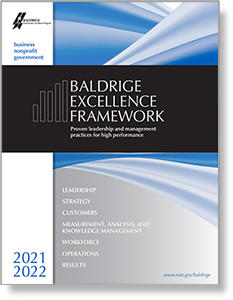Blogrige
The Official Baldrige Blog

I have always considered myself an inclusive leader. However, recent and needed heightened awareness of diversity, equity, and inclusion has led me to consider whether I truly am. So I considered how I would answer this question in the senior leadership item (1.1) of the Baldrige Performance Excellence Criteria:
- How do senior leaders create and reinforce a culture that fosters equity and inclusion?
I decided to do some reading on inclusive leadership. After analyzing the data, I have concluded that I have not been as inclusive as I could have been. There are some specific attributes of a truly inclusive leader on which I still need some development, and like all good leaders, I will continue to learn about all aspects of inclusive leadership.
Definitions
Before I delve deeper into this topic, let me share some definitions and descriptions to set some common ground. These are drawn from the 2021-2022 Baldrige Excellence Framework.
- Diversity: Personal differences among workforce members that enrich the work environment and are representative of your hiring and customer communities. These differences address many variables, such as race, religion, color, gender, national origin, disability, sexual orientation, age and generation, education, geographic origin, and skill characteristics, as well as ideas, thinking, academic disciplines, and perspectives.
- Equity: Ensuring that all customers and workforce members are treated fairly and that all workforce members can reach their full potential.
- Inclusion: Promoting the full participation of all workforce members and ensuring a sense of belonging for them. (I would add, based on my reading, that all workforce members perceive fairness in decision making and are empowered to bring their authentic selves to work.)
Diversity without Inclusion Is Chaos
After reading the definitions and thinking about them, I found it obvious that merely hiring for diversity is not enough. It is destructive for individual workforce members and the organization if the values and contributions of each person hired are not appreciated and recognized. It is inclusion, not mere presence, that yields benefit for all. Minority groups (in every sense of diversity) in the workforce must be appreciated for the unique and collective contributions they make as organizational contributors.
While I always appreciated this differentiation between diversity (and equity) and inclusion and put it into practice on a sub-conscious level, it was my recent reading that brought the important characteristics of inclusive leadership to the foreground in my thinking. That was my first lesson learned.
Inclusive Leadership Starts with Overall Good Leadership Practices
First let me share several generally accepted role-model leadership characteristics that also contribute to good inclusive leadership based on employee survey data. (I will share some of those data in the data section of this blog.)
- Open Communication: Good leaders share information. They demonstrate their personal values when they communicate. They know their audience and communicate in audience-specific language. They use examples relevant to the audience. (For example, a leader in a manufacturing company should use assembly-line examples, not boardroom examples when talking with assembly-line workers, no matter how relevant a boardroom example might be to the point the leader is making.) Good leaders are willing to challenge organizational attitudes and practices that require homogeneity.
- Empowerment and Collaboration: Good leaders set direction, encourage, and guide; they do not dictate how the work is to be accomplished. They collaborate with the workforce members to achieve their personal and organizational goals.
- Honesty: Good leaders are truthful in all communications. They hold themselves accountable for their personal actions and admit to their mistakes. They build trust and are trusted by their workforce, customers, community, and other key stakeholders.
- Humility: Good leaders set their own egos aside and focus on helping others succeed. They acknowledge and recognize the achievements of their colleagues and know their own success is based on the achievements of those colleagues. Good leaders ask for and utilize feedback, knowing that they can improve. They seek input from others to overcome their personal weaknesses and blind spots.
- Empathy and Caring: Good leaders are concerned about the well-being of all members of the workforce. They make sure everyone feels they have been heard and care about their feelings. Without prying, good leaders display a true interest in the lives of their colleagues and provide support. They have a deep-seated sense of fairness.
While I mentioned the concept of trust as part of honesty, it is obvious that each of the above characteristics, as well as those below, lead to trust in leadership. No employee will feel included without having trust in their leaders. And that trust yields higher employee engagement and better organizational performance results.
Inclusive Leadership Continues with Inclusive Leadership Practices
My second lesson learned came in discovering the specific practices of good leadership that are hallmarks of an inclusive leader, as follows.
- Awareness of Personal Biases: Inclusive leaders are aware of their personal blind spots as well as organizational blind spots that hamper them in making objective and fair decisions. They exert dedicated effort to prevent these biases from influencing people, customer, and community decisions. In an inclusive leadership assessment conducted by Juliet Bourke and Andrea Titus (reported in HBR) of 400 leaders involving 4,000 employees, a leader's awareness of personal and organizational biases was the factor that was most important to employees.
- Valuing Diverse Perspectives: Inclusive leaders desire exposure to different ideas and listen without judgment, valuing and validating each person's input, thereby unlocking the full potential of all people and the organization. Through an openness to differences, innovation and positive change are accomplished. Inclusive leaders seek to find common ground through valuing perspectives that differ from their own.
- Recognizing Each Person Is Unique: Inclusive leaders recognize that individual uniqueness leads to individual strengths that can help leaders and the organization. Inclusive leaders recognize the need for psychological safety for each contributor as a prerequisite for them to contribute their unique talents. Inclusive leaders recognize that investing in the development of each person inspires them to share their passions and build their own and the organization's strengths.
- Paying Attention to Cultural Differences: Inclusive leaders understand cultural differences among employee, customer, and other stakeholder groups. They use cultural intelligence to make groups with differing cultures feel comfortable in the leader's and each other's presence. Differences are acknowledged and used as a source of strength for the group. The leader's capacity for inclusiveness is enhanced by having experienced situations where the leader is in the minority. Undertaking an extended immersion in a different culture can grow one's awareness of cultural differences and their ability to be culturally inviting.
We All Are Leaders
While I have been writing about organization-level inclusive leaders, we all can be inclusive leaders within our spheres of influence and on our teams within a workforce. Every one of us can exhibit the overall good leadership and the inclusive leadership practices I have described. Each of us can ask for feedback on our unintended personal biases and improve on our sensitivity to the needs and contributions of our colleagues.
In addition, as many of us already have leaders who strive to be inclusive, we have a further responsibility. We have a responsibility to make known to our leaders what they can do to increase our sense of being included and to improve workplace practices.
Some Data
Inclusive leadership benefits you (as a leader) personally, your stakeholders, and your organization. Let me share some data about the benefits:
- From the study by Bourke and Titus: when employees have leaders who are aware of their personal biases and exhibit humility, employees have 25% higher feelings of inclusion. If their leaders also display high levels of empathy, the rate improves to 33%.
- From several studies on inclusive leadership reported by Korn Ferry: diverse and inclusive teams and organizations are
- 70% more likely to capture new markets
- 36% more likely to outperform on profitability
- 75% faster on time to market
- 19% better at innovation
The power of these data was my final lesson learned.
A Closing Image

Growing up, I always read and heard about the United States being a melting pot of diverse cultures blending together to form the American culture. Through my recent reading, I have learned that a much more appropriate image of the American culture is a mosaic, a combination of contributors who create a holistic, inclusive, beautiful American culture. To the case for switching metaphors from melting pot to mosaic, I add an observation made by my colleague Jackie DesChamps, who grew up near Pittsburgh. She pointed out that the steel melting pot generates steel and slag, a much less valuable by-product. This is certainly not an inclusive image.
Next Steps
Start with an honest assessment of the current status of diversity, equity, and inclusion in your organization.
- Are you and your organization contributing to the mosaic?
- Are you as a "leader" committed to inclusive behaviors?
If you would like to do some additional reading, consider these two articles (plus the ones referenced above): "6 Characteristics of Inclusive Leaders" and "Employees Sound Off on What Makes a Truly Inclusive Leader." If you would like to ask role model leaders about inclusive leadership, they will be available for questioning at the virtual Quest for Excellence Conference on April 12-15, 2021. See you there!
Resources
C – V = D (Culture Minus Values Equals Destiny) (December 2020)
The New Normal Will Require RE2ST3 (July 2020)
It Is 2020. Is Your CEO Thinking about Perpetual Reinvention? (January 2020)
Archived Columns

Baldrige Excellence Framework
The Baldrige Excellence Framework has empowered organizations to accomplish their missions, improve results, and become more competitive. It includes the Criteria for Performance Excellence, core values and concepts, and guidelines for evaluating your processes and results.
Purchase your copy today!
Available versions: Business/Nonprofit, Education, and Health Care





